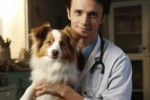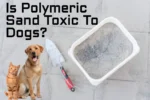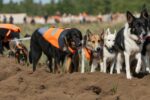Comprehensive Guide to Canine Eye Care
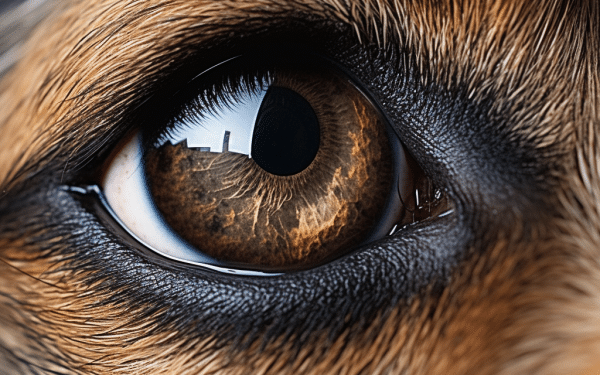
Dog eye problems are a common concern for pet owners. Canine eye care is crucial to maintaining your dog’s vision health. In this article, we will discuss various common dog eye issues and provide effective solutions.
Regular check-ups and proper care are essential for identifying and addressing dog eye problems. By understanding the signs and symptoms, you can take appropriate measures to ensure your pet’s well-being.
From eye infections to cherry eye, glaucoma, conjunctivitis, ectropion, entropion, cataracts, and even lazy eye, each condition requires specific attention. Our expert advice will guide you through the diagnosis and treatment options available.
By implementing the recommended solutions, you can help your dog maintain optimal vision health and prevent long-term complications. Stay informed, consult with a veterinarian, and provide the necessary dog eye problem solutions for a happy and healthy pet.
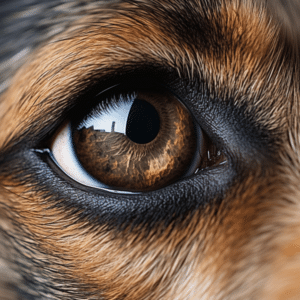
Dog Eye Infections
Dog eye infections, caused by bacteria, viruses, or fungi, are common and can lead to discomfort and vision problems. They affect various parts of the eye, including the eyelid, conjunctiva, and the eye itself, with signs like drainage, swelling, crusting, and redness.
Treatment involves vet-prescribed eye drops or antibiotics. Adhering to the treatment plan and keeping the affected area clean by gently wiping away discharge are crucial for a quick and effective recovery.
To prevent dog eye infections, maintain regular eye care. Keep the eye area clean and avoid irritants and allergens. Ensure a clean living environment to prevent irritation. Regular veterinary check-ups can identify infection signs early for timely treatment and prevention.
Common signs of dog eye infection:
- Drainage from the eyes
- Swelling
- Crusting
- Redness
“Proper treatment and regular veterinary check-ups are essential to address dog eye infections and ensure your pet’s vision health.”
| Treatment Options | Duration |
|---|---|
| Eye drops | Usually administered for a period of 7-10 days |
| Antibiotics | Length of antibiotic treatment can vary based on the severity of the infection |
Cherry Eye in Dogs
Cherry eye is a common condition in dogs where the tear gland on the third eyelid prolapses, causing a red and swollen mass in the corner of the eye. This condition is more common in certain breeds, such as Bulldogs and Cocker Spaniels, and usually affects younger dogs. While the exact cause of cherry eye is unknown, it is believed to be related to a weakness in the connective tissue that supports the tear gland.
Surgery is typically needed to treat cherry eye in dogs. The aim is to reposition the tear gland, restore tear production, and there are various surgical techniques, like suturing or removing the gland, depending on factors like severity and the dog’s health.
“Cherry eye surgery is usually successful in restoring the tear gland to its normal position and improving the dog’s eye health,” says Dr. Emily Johnson, a veterinary ophthalmologist. “It’s important to address cherry eye promptly to prevent complications such as dry eye and secondary infections.”
Treatment Options for Cherry Eye
In addition to surgery, other treatment options for cherry eye in dogs may include the use of topical medications to reduce inflammation and promote healing. However, these medications are often not a permanent solution and may only provide temporary relief. It’s crucial to consult with a veterinarian who specializes in ophthalmology to determine the most suitable treatment approach for your dog.
Prevention and Long-Term Outlook
While it may not be possible to prevent cherry eye entirely, there are some measures you can take to potentially reduce the risk. Avoid any activities or situations that could put excessive pressure on your dog’s eyes, such as rough play or exposure to irritants. Regular eye examinations by a veterinarian can also help detect any early signs of cherry eye, allowing for prompt treatment.
With proper treatment and follow-up care, the prognosis for dogs with cherry eye is generally good. However, it’s important to note that cherry eye may recur even after surgery, especially in cases where the tear gland is not fully repositioned or the underlying connective tissue weakness is not completely addressed.
| Pros of Cherry Eye Surgery | Cons of Cherry Eye Surgery |
|---|---|
| Surgery can reposition the tear gland and restore normal tear production. | There is a risk of recurrence, especially if the tear gland is not properly repositioned. |
| Improves the dog’s eye health and reduces the risk of complications. | Surgery carries inherent risks, including anesthesia complications and surgical site infection. |
| Can alleviate discomfort and irritation caused by the prolapsed gland. | Some dogs may experience temporary swelling and discomfort after surgery. |
Glaucoma in Dogs
Canine glaucoma harms dogs’ eyes due to high eye pressure, potentially causing vision loss, linked to fluid issues or eye structure problems.
If left untreated, glaucoma can cause pain, cloudiness in the eye, and eventually blindness. Therefore, early detection and prompt treatment are crucial to managing this condition. If you notice any symptoms such as redness, excessive tearing, squinting, or a change in the size or appearance of your dog’s eyes, it is important to seek veterinary attention.
Canine Glaucoma Treatment
The treatment for glaucoma in dogs typically involves reducing the pressure within the eye. This can be achieved through the use of eye drops or medications that help to drain fluid from the eye. Your veterinarian may also recommend oral medications to manage the underlying cause of the glaucoma.
In some cases, surgical intervention may be necessary to alleviate the pressure and prevent further damage to the optic nerve. Surgical options may include laser therapy, drainage implants, or even removal of the affected eye if it has become irreversibly damaged.
| Treatment Options | Benefits | Drawbacks |
|---|---|---|
| Eye drops | – Easy to administer – Can reduce eye pressure effectively |
– Frequent application required – Potential side effects |
| Medications | – Systemic treatment for underlying causes – Can help manage eye pressure |
– Regular monitoring and bloodwork necessary – Potential side effects |
| Surgical intervention | – Can provide long-term relief of pressure – Prevents further damage to the optic nerve |
– More invasive procedure – Potential complications |
It is important to work closely with your veterinarian to determine the most appropriate treatment plan for your dog’s specific case of glaucoma. Regular follow-up appointments and ongoing monitoring of eye pressure may be necessary to ensure the effectiveness of the chosen treatment and to make any necessary adjustments.
Conjunctivitis/Pinkeye in Dogs
Conjunctivitis, or pink eye in dogs, inflames the eye’s inner membrane and white part, caused by allergies, infections, or irritants. It may affect one or both eyes, causing discomfort and vision problems. Timely treatment is crucial for relief and healing.
Common signs of conjunctivitis in dogs include redness, discharge, squinting, and sensitivity to light. Your veterinarian will conduct a thorough examination to diagnose the underlying cause and recommend appropriate treatment options. In some cases, a sample of the eye discharge may be collected for further analysis.
Treatment for conjunctivitis in dogs often involves the use of topical medications, such as eye drops or ointments, to reduce inflammation and combat infection. Your veterinarian may also recommend cleaning the affected area with a saline solution to remove any debris or discharge. It is important to follow the prescribed treatment regimen and administer the medications as instructed by your veterinarian to ensure effective healing.
Symptoms of Conjunctivitis in Dogs:
- Redness in the eyes
- Discharge from the eyes
- Squinting
- Sensitivity to light
Conjunctivitis in dogs can cause discomfort and affect your pet’s vision if left untreated. Prompt treatment is essential to alleviate symptoms and promote healing.
| Treatment Options for Conjunctivitis in Dogs | Description |
|---|---|
| Topical Medications | Eye drops or ointments to reduce inflammation and combat infection |
| Saline Solution | Cleaning the affected area to remove debris or discharge |
| Follow-up Examination | Regular check-ups with your veterinarian to monitor progress and adjust treatment if necessary |
Ectropion in Dogs
Ectropion is a condition that commonly affects dogs, characterized by a drooping or folding outward of the lower eyelid. This abnormality exposes the inner surface of the eyelid and can lead to various complications if left untreated.
Dogs with ectropion may experience chronic inflammation, dry eyes, and increased susceptibility to infections. The condition can be more prevalent in certain breeds with loose facial skin, such as Bloodhounds, St. Bernards, and Cocker Spaniels.
Treatment options for ectropion in dogs typically involve surgical correction of the eyelid. Ectropion surgery aims to restore the normal position of the eyelid, alleviate symptoms, and prevent further complications. During the procedure, the excess skin and tissues are carefully removed, and the lower eyelid is repositioned to prevent it from folding outward.
| Treatment option | Description |
|---|---|
| Ectropion surgery | A surgical procedure where the excess skin and tissues of the lower eyelid are removed, and the eyelid is repositioned to correct the drooping or folding outward. |
| Post-operative care | After the surgery, it is important to closely follow the veterinarian’s instructions for post-operative care, which may include administering medications, applying ointments, and monitoring the healing process. |
| Regular check-ups | Regular check-ups with the veterinarian are important to monitor the dog’s recovery and ensure the surgical correction is successful. It also allows for early detection of any complications or issues that may arise. |
If you suspect that your dog may have ectropion or any other eye-related issue, it is crucial to seek veterinary advice promptly. A professional evaluation and diagnosis will determine the most appropriate treatment plan for your furry friend. Remember, early intervention can help prevent potential discomfort and complications associated with ectropion in dogs.
Entropion in Dogs
Entropion is a condition characterized by the rolling inward of the eyelid, causing the eyelashes to rub against the surface of the eye. This can lead to irritation, injury, and even vision loss if left untreated. If your dog is displaying signs of entropion, such as excessive tearing, squinting, or redness, it is important to consult with a veterinarian for an accurate diagnosis and appropriate treatment options.
Symptoms of Entropion
The symptoms of entropion in dogs may include:
- Excessive tearing
- Squinting or closing of the affected eye
- Redness and inflammation
- Rubbing or pawing at the eye
- Corneal ulcers or other eye infections
If left untreated, entropion can lead to more serious complications such as corneal damage, scarring, and impaired vision. It is important to seek veterinary care promptly to prevent further problems.
Treatment Options
The most common treatment for entropion in dogs is surgical correction of the eyelid. The procedure involves modifying the eyelid to ensure that it rolls outward, away from the eye, preventing the eyelashes from rubbing against the cornea. This surgery is typically performed under general anesthesia and has a high success rate.
During the recovery period, it is important to follow your veterinarian’s post-operative instructions, which may include administering prescribed medications, keeping the surgical site clean, and preventing your dog from rubbing or scratching at the area.
| Benefits of Entropion Surgery | Risks and Considerations |
|---|---|
| Relief from discomfort and irritation | Potential risks associated with anesthesia |
| Prevention of corneal damage and ulcers | Possible complications during the healing process |
| Improved vision and quality of life | Cost of surgery and follow-up care |
“Entropion surgery can greatly improve the comfort and quality of life for dogs affected by this condition. It is important to consult with a veterinary ophthalmologist to determine the best course of action for your pet.”
Cataracts in Dogs
Cataracts are a common eye condition in dogs that result in the clouding of the eye’s lens, leading to impaired vision and potential blindness. They can occur due to various factors, including genetics, aging, or underlying health conditions. If left untreated, cataracts can significantly impact a dog’s quality of life. However, with timely diagnosis and appropriate treatment, dogs with cataracts can regain their vision and continue to enjoy a happy and active life.
Canine cataract surgery is a commonly used treatment option for dogs with advanced cataracts. The procedure involves removing the cloudy lens and replacing it with an artificial lens, allowing light to pass through and restore clear vision. While the surgery is generally safe and has a high success rate, it is important to consult with a veterinary ophthalmologist to determine if your dog is a suitable candidate for the procedure.
Early detection
Early detection and management are key in preventing cataracts from progressing to an advanced stage. Regular eye examinations by a veterinarian can help identify cataracts in their early stages, before they cause significant vision impairment. In some cases, medical management may be recommended to slow down the progression of cataracts and alleviate associated symptoms. This may involve the use of medications or specialized eye drops prescribed by a veterinarian.
| Treatment Options for Cataracts in Dogs | Advantages | Disadvantages |
|---|---|---|
| Canine Cataract Surgery |
|
|
| Medical Management |
|
|
“Early detection and prompt intervention are crucial in managing cataracts in dogs. If you notice any changes in your dog’s eyes, such as cloudiness or a decrease in vision, it is important to seek veterinary attention immediately. Your veterinarian can perform a thorough eye examination and guide you on the most appropriate treatment options for your dog’s specific condition.”
It is important to remember that not all cataracts require immediate treatment. In some cases, smaller or early-stage cataracts may not significantly impact a dog’s vision or quality of life. Regular monitoring by a veterinarian can help determine the appropriate course of action based on the progression and severity of the cataracts.
Lazy Eye in Dogs
Lazy eye, or strabismus in dogs, results in one or both eyes misaligned, potentially leading to visual impairment and complications if not treated. While some dogs have congenital strabismus without problems, sudden-onset strabismus should prompt a veterinary evaluation as it might indicate neurological issues or eye disorders.
Diagnosing lazy eye in dogs requires a comprehensive veterinary examination, assessing eye alignment, visual acuity, and overall eye health. Additional tests, like neurologic evaluations or imaging studies, may be advised to identify the strabismus’s root cause in specific cases.
The treatment for lazy eye in dogs depends on the cause and severity. Addressing the underlying issue, like managing an eye infection or injury, can help. If misalignment persists or causes discomfort, surgery may be needed. Strabismus surgery realigns the eye(s) to improve vision and quality of life.
| Lazy Eye in Dogs: Key Points |
|---|
| Lazy eye, or strabismus, is a condition characterized by misalignment of one or both eyes in dogs. |
| Veterinary evaluation is crucial to determine the underlying cause of strabismus and identify any associated eye disorders or neurological problems. |
| Treatment options for lazy eye in dogs may include addressing the underlying issue, such as infection or injury, or surgical intervention to realign the affected eye(s). |
It is important for dog owners to be aware of the signs and symptoms of lazy eye, such as noticeable eye misalignment, squinting, or reduced visual response. Early detection and prompt veterinary care can improve the chances of successful treatment and minimize the risk of long-term complications. If you suspect your dog may have lazy eye, consult with a veterinarian for an accurate diagnosis and tailored treatment plan.
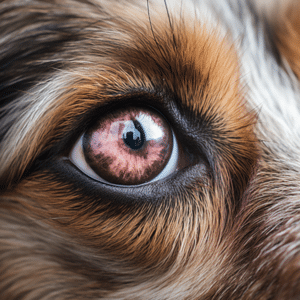
Conclusion
Proper care and prompt treatment are crucial for maintaining your dog’s vision health and addressing common dog eye problems. Regular veterinary check-ups are essential to detect any signs or symptoms early on. By seeking professional guidance, you can ensure accurate diagnosis and tailored treatment plans for your dog’s specific conditions.
Remember, early intervention is key to preventing long-term complications and ensuring your dog’s well-being. Whether it’s treating dog eye infections, addressing cherry eye or glaucoma, managing conjunctivitis or cataracts, correcting ectropion or entropion, or evaluating lazy eye, seeking timely medical attention is vital.
Alongside professional care, practicing proper dog eye care at home is equally important. Regularly clean your dog’s eyes with a veterinarian-approved solution, and be mindful of any changes in their eye appearance or behavior. Additionally, keeping your dog’s environment free from potential eye irritants can help in maintaining their vision health.
By prioritizing your dog’s eye health and taking necessary precautions, you can ensure your furry friend enjoys a lifetime of clear vision and healthy eyes. Remember that every dog is unique, so consulting with a veterinarian is crucial to address their specific needs and provide the best possible care.
FAQ
Are dog eye infections common?
Yes, dog eye infections are relatively common and can be caused by bacteria, viruses, or fungus.
What are the common signs of a dog eye infection?
Common signs of a dog eye infection include drainage from the eyes, swelling, crusting, and redness.
How are dog eye infections treated?
Treatment for dog eye infections usually involves the use of eye drops or antibiotics prescribed by a veterinarian.
What is cherry eye in dogs?
Cherry eye is a condition where the tear gland on a dog’s third eyelid prolapses, causing a red and swollen mass in the corner of the eye.
Do all dogs require surgery for cherry eye?
Surgery often fixes cherry eye in dogs, but treatment varies based on severity.
What is glaucoma in dogs?
Increased eye pressure in glaucoma causes pain, cloudiness, and potential vision loss.
How is glaucoma in dogs treated?
Treatment for glaucoma in dogs typically involves medication to reduce eye pressure, but in some cases, surgical removal of the affected eye may be necessary.
What is conjunctivitis in dogs?
Conjunctivitis, also known as pink eye, is an inflammation of the conjunctiva, the membrane covering the inner eyelid and the white part of the eye.
What are the symptoms of conjunctivitis in dogs?
Symptoms of conjunctivitis in dogs include redness, discharge, and squinting.
How is conjunctivitis in dogs treated?
Treatment for conjunctivitis in dogs often involves the use of eye drops or ointments to alleviate inflammation and promote healing.
What is ectropion in dogs?
Ectropion is a condition where the lower eyelid droops or folds outward, exposing the inner surface of the eyelid.
Can ectropion in dogs lead to complications?
In some cases, ectropion in dogs can lead to chronic inflammation, dry eyes, and infections.
How is ectropion in dogs treated?
Treatment options for ectropion in dogs include surgery to correct the abnormality and prevent further complications.
What is entropion in dogs?
Entropion rolls the eyelid inward, making eyelashes rub the eye’s surface.
What problems can entropion in dogs cause?
Entropion in dogs can lead to irritation, injury, and even vision loss if left untreated.
How is entropion in dogs treated?
Treatment usually involves surgical correction of the eyelid to alleviate the rubbing and prevent further damage.
What are cataracts in dogs?
Cataracts cloud the eye’s lens, causing blurred vision and potential blindness.
What causes cataracts in dogs?
Genetics, aging, or health issues can cause cataracts in dogs.
How are cataracts in dogs treated?
Treatment options for cataracts in dogs may include surgical removal of the affected lens or medical management, depending on the severity of the condition.
What is lazy eye in dogs?
Lazy eye, or strabismus, misaligns and deviates one or both eyes.
When should I be concerned about lazy eye in my dog?
A veterinarian should assess sudden strabismus, as it may indicate hidden neurological issues or eye disorders.
How can I ensure my dog’s vision health?
Proper care and prompt treatment of common dog eye problems are essential for maintaining your pet’s vision health. Regular veterinary check-ups, early detection of signs and symptoms, and appropriate treatment can help prevent long-term complications.
